Page 2 of 4
Campus Housing: Expectations vs. Reality
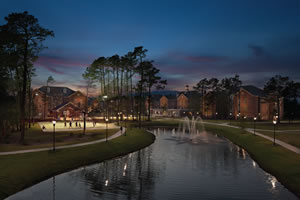
PHOTO © MACKEY MITCHELL ARCHITECTS
As we do each year, College Planning & Management
recently surveyed college and university housing
administrators to find out what challenges they are
facing, the state of their facilities and what improvements
they would like to see in their residential life programs
and buildings. Here are some results from that survey.
WHAT EXPECTATIONS DO INCOMING STUDENTS HAVE FOR ON-CAMPUS HOUSING?
Big ones. They want it all. “It” being privacy;
convenience; lots of space; cutting-edge technology (and the very best
WiFi); cable TV; their own kitchens, laundry facilities and bathrooms;
comfortable, quality furniture; close access to food service; air conditioning;
a rec center; attentive housing staff; and their own parking
space… right outside the door. And they want this “resort experience”
at an affordable price.
As Mick Jagger and his bandmates reminded us long before today’s
students were in this world, however: you can’t always get what you want.
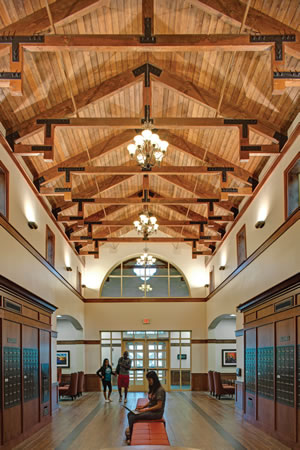
PHOTO © MACKEY MITCHELL ARCHITECTS
When College Planning & Management asked campus housing
directors and administrators the question concerning what expectations
students have for housing, the dissonance between the list of students’ desired
amenities and what housing directors are currently able to provide
or are focused on providing — a sufficient number of beds, roofs that
don’t leak, mechanical system upgrades (HVAC, lighting, etc.), remodeled
bathrooms, life-safety additions/upgrades, etc. — was substantial.
When asked to rate the impact several issues will have on housing
at their institutions in the next three to five years, over half of survey respondents (53 percent) indicated that
aging facilities would have a profound
impact. The next frequently mentioned
item on the list of profound impact issues
was deferred maintenance (35 percent
of respondents), followed closely by lack
of adequate funds (34 percent). Housing
programs that are walking a narrow line
between keeping their current building
stock functional, comfortable and safe and
student expectations for something akin to
the good life on campus are probably not
ready to offer students high-end amenities.
With that observation made, what do
our survey respondents have to say about
the state of their campus housing stock, as
well as the students living within it?
Space. Too Much? Too Little? Just Enough?
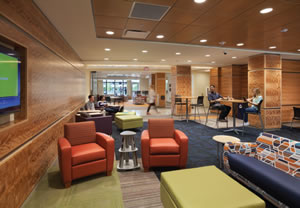
PHOTO © MACKEY MITCHELL ARCHITECTS
Depending on where you look for
statistics, the number of students enrolling
in colleges or universities is increasing,
decreasing or remaining about the same.
The growth of online learning, although
slowing somewhat, is allowing students —
both traditional and nontraditional — to
learn from where they currently live, with no
need to travel to or reside on a college or university
campus. Regardless of those trends,
campus housing remains a marketing tool
for institutions looking to draw students to
and keep them on campus. Schools need
to offer sufficient beds and accompanying
amenities. Too much real estate tied up in
residence halls that are under-occupied is
a drain on budgets and resources, but not
having sufficient space for potential and
current students might cause those students
to move along to an institution that can
meet their desires as well as their needs. Are
there sufficient beds available today?
When CP&M surveyed housing administrators
last year, 54 percent of respondents indicated
they have sufficient space, 38 percent
indicated too little and 8 percent indicated
they have too much, resulting in unfilled
beds. This year, the number of respondents
indicating they have sufficient space has risen
to 60 percent; 32 percent indicated they have
too little (a 6 percent drop) and again, only 8
percent say they have too much.
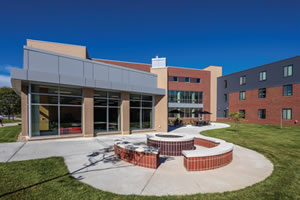
PHOTO © MACKEY MITCHELL ARCHITECTS
Up 8 percent from last year, 88 percent
said they are not planning to add any new
residence halls to campus in 2017-2018; 12
percent said they are. Of those 12 percent
adding to their stock, 63 percent are doing
so to increase the number of beds available.
Thirty-eight percent are replacing existing
facilities. And over one-third of them (38
percent) intend for these new facilities to
improve their school’s marketability/help
with recruiting new students, and also to
keep current students living on campus.
Perhaps aligned with this goal, 13 percent
are building these facilities to create specialized
living/learning communities (for
first-generation students, or family housing
space, to cluster students who are enrolled
in similar programs together, etc.).
Jordan Gatewood, AIA, LEED-BD+C,
senior associate for Mackey Mitchell
Architects in St. Louis, sees this trend in
creating a sense of community, as well as a
concern for all-around health and wellness,
for residential students.
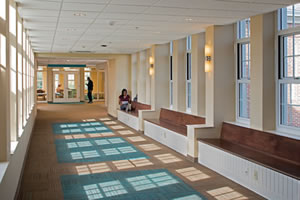
PHOTO © MACKEY MITCHELL ARCHITECTS
“Institutions are increasingly interested
in building spaces which promote living
learning community,” he says. “Writable
surfaces are everywhere as are tech-enabled
rooms for small group study. Institutions are
all looking at the issue of health and wellness
which translates in different ways on individual
campuses. Offices for counselors, small
fitness rooms (typically cardio equipment),
meditation rooms, community kitchens
where dietitians can interact with students
are all examples of spaces we are designing to
promote wellness in residence halls.”
CP&M did not ask a question this year
concerning who is developing, building, and
funding new residence halls — the school
itself, a private developer or a public-private
(P3) partnership. For most, funding new
residence halls is a prime concern, however,
with one survey respondent observing that
the issue of most concern is that “developer
P3 construction projects are necessitated.”
Gatewood sees that as well.
“P3 delivery is gaining more traction
as an option for institutions that may
otherwise not be able to afford to build new
housing,” he confirms. “As states like Georgia adopt and deploy
P3 delivery at a system-wide level it will inevitably increase the
amount of P3 projects.”
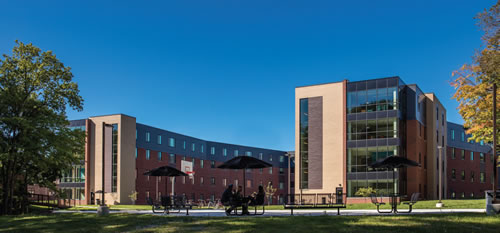
PHOTO © MACKEY MITCHELL ARCHITECTS
Maintaining What’s in Place
Where new facilities are not in progress, the looming specter of
deferred maintenance, along with routine maintenance, renovations
and upgrades are keeping housing administrators busy. In
2016, 51 percent of survey respondents indicated that they had
renovations in progress, while 17 percent had renovations on
hold due to budget constraints. Last year, just about one-third of
respondents had no major renovations planned.
In 2017, the percentage who responded that they currently have
renovations underway dropped to 44 percent. The number with projects
on hold due to budget constraints rose just one point, to 18 percent,
while 38 percent have no major renovations/upgrades planned.
That number of facilities being renovated rather than being built
from scratch is confirmed Gatewood. When asked if his firm is seeing
more new construction or renovation of existing building stock, he
says, “We have seen a fairly equal split between new and renovated
facilities. Many institutions are conducting housing master plans
in order to evaluate renovation and new construction scenarios.
Strategic decision making is critical as construction costs continue to
increase and schools try to keep on campus housing affordable.”

Table 1 indicates the types of renovations or upgrades that are
underway or planned for the next three to five years. A full 96 percent
of respondents indicate that general maintenance, painting
and repair are on the agenda. That is comparable to last year, when
94 percent had general maintenance tasks underway. Seventy
percent of respondents say carpeting and flooring replacement
are necessary or in the works, a drop from last year’s 84 percent,
and almost 72 percent are planning or are undertaking furniture
and fixtures replacement (last year it was 75 percent). The general
consensus is that students are often hard on housing; keeping up
appearances with general/routine maintenance of walls, floors,
furniture and fixtures is a vital minimum to keep residence hall
spaces functional and appealing to new and returning occupants.
What’s in a Residence Hall? What Should Be?
As noted, it seems that many students (and their parents)
expect a “home away from home” experience in campus living, or
even “resort living away from home.” With that said, there is no
ideal, “one size fits all” cookie-cutter format for a residence hall.
There are, however, common and/or popular amenities that are
included or desired across the board.
In 2016, 93 percent of respondents indicated that their residence
hall spaces included central laundry facilities. This year, that number
rose to 98 percent. In 2016, 49 percent indicated the existence
of full-service central kitchens; this year that dropped slightly to
44 percent. In the spirit of students wanting their own version of
amenities, in 2016, survey respondents indicated that 29 percent of
residence hall spaces do or will include kitchens in rooms. In 2017,
that number rose sharply, to 47 percent.
Dining halls within a residential facility? In 2016, 37 percent
responded in the affirmative. That number dropped slightly this
year, to 35 percent. Perhaps the increase of private kitchen facilities
(we will assume within suites of rooms) is eliminating the need for
central dining facilities.
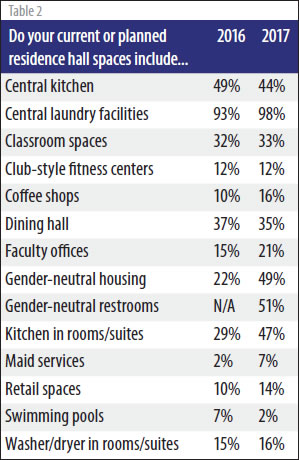 Despite our survey respondents’ indication of a shift towards
kitchens within rooms, Mackey Mitchell’s Gatewood is still seeing
the central kitchen as a desired element. It seems a “foodie” culture is
taking root.
Despite our survey respondents’ indication of a shift towards
kitchens within rooms, Mackey Mitchell’s Gatewood is still seeing
the central kitchen as a desired element. It seems a “foodie” culture is
taking root.
“Today’s students are much more engaged and interested in
food than previous generations have been,” he says. “Couple that
with increasing international student enrollment and a community
kitchen is now an important component of
building community in the residence hall.
Community kitchens provide opportunities
for students to cook together, campus
dietitians can conduct educational programs
about healthy eating and cooking,
and international students are able to cook
native cuisine for themselves and introduce
hall mates to food from different cultures.
Many of the community kitchens we have
designed recently include two of each
appliance to satisfy demand and provide
opportunity for ‘iron chef’ type cooking
matches between students.”
Coffee shops within residence halls? In
2016, only 10 percent indicated they were
or would be included. That number rose to
16 percent in 2017.
Classroom spaces were indicated for 32
percent of facilities in 2016; that number
remains steady in 2017, at 33 percent.
Inspired by current, sometimes acrimonious
discussion, CP&M asked if campus
residence halls do or will include genderneutral
housing. Almost half, 49 percent,
indicated they do or will; and gender-neutral
restrooms — over half, 51 percent, do or will.
Gatewood sees this evolution from the
design end.
“Campus housing continues to be
impacted by the legislation and discussion
surrounding issues of transgender
and gender-neutral accommodations,” he
observes. “Largely, institutions of higher
education have been ahead of the curve
on addressing these issues in new and
renovated facilities. Architects are increasingly
challenged to create safe, equitable
living environments on college campuses.
Engaging all users of the facility in the
design process rather than relying on assumptions
helps ensure everyone’s needs
for privacy and security are being met to
the greatest extent possible.”
Looking Forward,
What Are the Concerns?
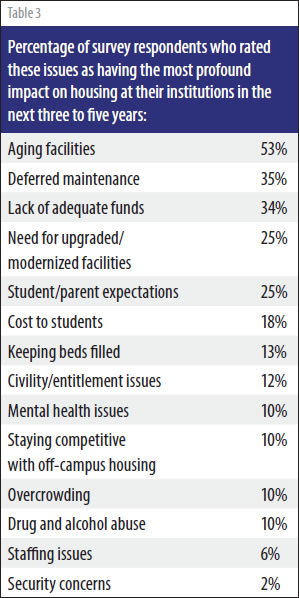 The eyes of housing directors remain
firmly focused on budget.
The eyes of housing directors remain
firmly focused on budget.
When asked to rate the impact of a
number of issues on housing at their
institutions in the next three to five years,
the five issues ranked as having the most
profound impact were aging facilities,
deferred maintenance, lack of adequate
funds, need for upgraded/modernized facilities
and student/parent expectations…
which is exactly the same as 2016’s top five.
And as last year, except perhaps for student/parent expectations, the top four are
directly related to financial considerations.
From the same question, the five
items most often cited as not having any
noticeable impact for the next three to
five years are overcrowding, keeping beds
filled, staffing issues, staying competitive
with off-campus housing and security concerns.
It Comes Down to the Students
Once the physical needs of shelter and safety are met — as
close to student expectations as possible, knowing that the wishlist
will almost always exceed availability — we asked our survey
respondents what is the one issue that concerns them most right
now, and why.
Costs, funding and condition of facilities top the list. Competition
with off-campus facilities concerns some. Cited more
frequently through the years of compiling these surveys however,
is the answer “mental health.”
“Mental health. Students are very fragile, requiring increasing
amounts of staff time,” one respondent notes. “Civility and mental
health,” says another. “Mental health issues,” agree several more.
“Mental health issues have been on the rise for the past 10
years, and it is a challenge for on-campus counseling centers to
keep up with the demand,” opines one survey respondent. “There
is this perception that college students are babied and coddled,
and at times, this is not wrong. There is an apex where care falls
from enough to too much… and I wonder if we have fallen over to
that side, as a field. There should be safe feelings on campus, but at
what cost? To assist people from overcoming adversity or to make
it where ‘bad things’ don’t even exist on a campus. I am afraid
when we send students out into the ‘real world’ and they are faced
with hate, discrimination, ideas they find offensive, etc., that they
won’t know how to handle them appropriately; I am afraid they
will either shatter internally or go on the offensive.”
Tangential to concern over student mental health is a new
response to CP&M’s question on current concerns this year: “Comfort
pets,” and “emotional support animals.”
“Kansas law allowing guns on campus,” states another.
And along those lines of the student experience, what is the
biggest change housing experts have seen in their residence halls
in the last five years?
The demand for amenities clearly tops the list. With the word
“demand” being key.
“The desire for more private spaces and additional amenities.”
“There is a stark difference between our older residence halls and new
residence halls. Students are also asking for more private amenities —
such as laundry within rooms, more kitchens.” “The demand for services.
Parents who go to the top immediately if they feel their own personal
expectations are not being met for their son or daughter.” “Demand to
be closer to dining choices, classrooms, rec center.” “Demand for private
rooms.” “It’s very hard to keep up with the demands of incoming
students and their parents,” responds one. “It is always a balancing act
between facility management and program management.”
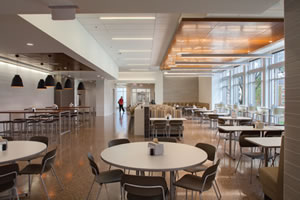
PHOTO © MACKEY MITCHELL ARCHITECTS
A few mentioned increased use of marijuana as the biggest
change noted, while another noted a “decrease in alcohol use and
increase in drug use.” Gender identity issues received two mentions.
Campus housing directors are on the front lines, working out
the balance between student/parent wants and needs; residents’
safety and security; institutional budgets; what can be accomplished
realistically and what cannot; and keeping existing
facilities up and running, attractive and functional. In the face of
the ongoing challenges, they’re succeeding. “[Residence life on our
campus is] very much improving and more attractive to incoming
students, observes a respondent.
CP&M would like to thank the housing directors who responded
to our 2017 survey. The survey data was collected from 50 colleges
and universities (45 four-year, five two-year; 31 public, 17 nonprofit,
two for-profit) representing 25 states and the U.S. Virgin
Islands. A total of 993 residential facilities are located on the
campuses of and/or or managed by the respondents.
This article originally appeared in the issue of .